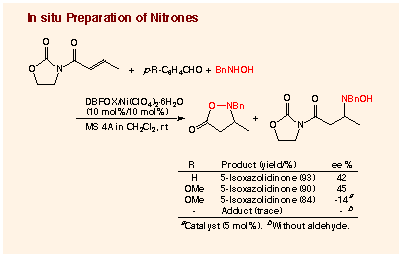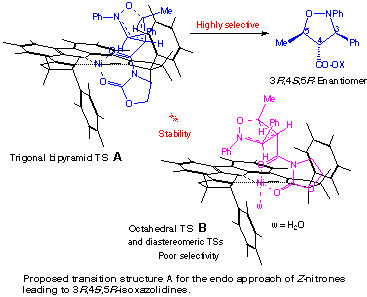
D02 Role of MS 4A and Transition Structure of Nitrone Cycloadditions
Role of MS 4A:
MS
4A works as powerful dehydrating agent. In the absence of water, we propose
that the nitrone cycloaddition takes place through the transition structure
including a trigonal bipyramid complex. When water is present in the reaction
system, an octahedral complex becomes more stable by coordination of water
to the metal center so that the reaction cite becomes more open. This is
the reason that the endo- and enantioselectivities are both lowered. This
will be discussed below.
The aqua complex derived from DBFOX/Ph and Ni(ClO4)2´6H2O is stable against water. To utilize this advantage, the nitrone synthesis and cycloaddition sequence was examined in one flask: Reaction of N-benzylhydroxylamine with aldehydes in the presence of the aqua complex and 3-crotonoyl-2-oxazolidinone was performed. The product obtained in high yields was 2-benzyl-3-methyl-5-isoxazolidinone, which is the addition/condensation product. This indicates that the conjugate addition is effectively catalyzed by DBFOX/Ph´Ni(ClO4)2´3H2O and is faster than the condensation leading to nitrone formation. However, enantioselectivity was not satisfactory.
As easily anticipated, nitrones are activated by complexiation to the DBFOX/Ph complex catalyst so that water adds to the C=N bond of activated nitrones. When a sufficient amount of water is present, hydrolysis of nitrones takes place to give N-substituted hydroxylamines. Then, the above 5-isoxazolidinone is formed, albeit a poor yield.

Transition State Structure:
Absolute configurations of isoxazolidines obtained from acyclic
nitrones, such as N-benzylidenebenzylamine or N-benzylideneaniline N-oxides,
were determined to be 3R,4S,5R structure. Thus, the Si-face at the C-beta
carbon of 3-crotonoyl-2-oxazolidine has been involved in the cycloaddition.
The Si-face (C-beta) selection in nitrone cycloadditions is the same to
the selectivity observed in the Diels-Alder reactions using the same dienophile
and cyclopentadiene in the presence of the DBFOX/Ph´Ni(ClO4)2´3H2O complex.
This indicates that the s-cis conformation of 3-crotonoyl-2-oxazolidinone
has participated in the reaction.
Regarding the role of MS 4A, the simple structure of DBFOX complex catalyst enables to discuss the transition structure as follows: On the basis of molecular model inspection and variable temperature 1H NMR analysis of the complex derived from DBFOX/Ph, Zn(ClO4)2, 3-acetyl-2-oxazolidinone, the nitrone cycloaddition in the presence of MS 4A is most likely to proceed through the transition structure A with trigonal bipyramid structure. Therein, chiral shielding by one of the 4-phenyl substituent becomes very effective for the endo approach of nitrone and the other 4-phenyl substituent inhibits the exo approach. As a result, the reaction shows high endo- and enantioselectivities in the absence of water. When a water molecule coordinates on the nickel ion, octahedral transition structure B becomes predominant. Based on the trans effect by aqua ligand, the octahedral substrate complex derived from the aqua complex should be less reactive than the anhydrous substrate complex. Therefore, transition state B should be less stabilized than A. In the case of octahedral transition state B, the reaction site of the coordinated substrate is more open for the approach of nitrone, and both the Si- and Re-face (Cbeta) allows the attack of nitrone, showing low enantioselectivity. In addition, the exo approach of nitrone leading to 3,4-cis-isoxazolidines is not difficult, poor endo selectivity having resulted.
